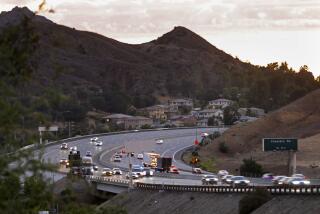Toll lanes coming to 10 and 110 freeways in Los Angeles County

Officials broke ground on what will be Los Angeles County’s first freeway toll lanes, taking a gamble that drivers will be willing to pay significant sums to avoid rush-hour traffic.
Mayor Antonio Villaraigosa and other officials on Wednesday hailed the project as a major improvement to L.A.’s clogged freeway system. Officials plan to convert a total of 25 miles of existing carpool lanes on the 10 and 110 freeways into high-occupancy toll lanes. Carpools and buses will be able to use the lanes for free, while solo drivers will pay up to $1.40 a mile during peak rush-hour traffic.
“Today marks a major milestone,” Villaraigosa said, adding that the HOT lanes could be expanded to other freeways if the pilot program is successful.
But the toll lanes still face some tough financial and political questions. To the south, Orange County has one of the nation’s largest networks of toll lanes and toll roads, which have been hit hard by the recession. Ridership is down on all of Orange County’s toll roads — notably the 91 Express Lanes, which is a model for the L.A. County experiment. Riders on the 91 can pay up to $9.75 to use about 10 miles of toll lanes during rush hour.
Roughly 11 million trips were recorded on the 91 Express Lanes last year, compared with 11.5 million the year before, said Joel Zlotnik, a spokesman for the Orange County Transportation Authority. Those numbers were down from annual totals between 13 million and 14 million before the recession.
Converting carpool lanes into toll lanes has also been hit with opposition from some on the left and the right, including two influential members of Congress from California.
Rep. Gary G. Miller of Diamond Bar, the senior California Republican on the House Transportation Committee, said earlier this year that the toll amounts to double taxation and “absolutely infuriates” him. Rep. Maxine Waters (D-Los Angeles) said it would set up a “traffic system of haves and have-nots.”
In response to critics who said toll lanes discriminate against low-income drivers, the pilot program will offer a $25 discount on the $75 deposit required to set up a prepaid toll account for lane users with household incomes of $35,000 or less.
The Metropolitan Transportation Authority estimates that 5,000 to 7,500 people a day will use the lanes, which are projected to generate $20 million in revenue during the pilot year.
Revenues will be used for improvements to the transportation system, said spokesman Rick Jager.
Tolls will vary from 25 cents to $1.40 a mile depending on traffic — the more congested, the higher the price to keep added cars from clogging the lanes. If the speed of traffic falls below 45 mph for more than 10 minutes, the lanes will be closed to solo drivers until speeds increase.
At the maximum rate, drivers could pay almost $20 to drive the 14-mile length of the 10 Freeway’s toll lane, but Metro estimates that the
average user will pay $6
per trip on the 10 and $4 per trip on the 110 during peak times.
A $210-million federal grant will fund the majority of the one-year pilot program on the 10 between Alameda Street and the 605 and on the 110 between Adams Boulevard and the Artesia Transit Center. Both are projected to open by 2013. The grant is also funding transit system improvements along the corridor, including 59 new alternative-fuel buses.
To drive in the HOT lanes, motorists must have a transponder that will be read by sensors on the roadway and will automatically charge the user’s account.
Carpoolers will be able to set them to reflect that the vehicle has multiple occupants so they will not be charged (except during peak hours on the 10, when cars must have at least three occupants to ride for free). Solo drivers of electric and natural gas vehicles, who get a free pass on carpool lanes elsewhere in the county, will have to pay the same toll as other lone motorists in the new HOT lanes.
The L.A. toll lane experiment has generated much excitement in transportation circles, with some experts arguing that if they can work in the car-culture capital of the nation, they can work anywhere.
“A lot of people look to California for innovation, and they look to California for transportation management options,” said James Moore, a civil engineering professor at USC. “Transportation economists have argued for over 50 years that the only really systemic solution to congestion is tolling.”
Experts also downplayed the need for the toll lanes to generate income, noting that the main goal should be to move people more efficiently.
Many toll lane backers say that putting a high price on congestion-free driving can encourage people who can’t or won’t pay the high tolls to consider mass transit or carpooling. Moving toll drivers out of the main lanes of traffic could also ease congestion overall.
“It’s really not meant so much as a revenue-generating device as it is a congestion-management device,” said Martin Wachs, a transportation expert at the Santa Monica-based think tank Rand Corp.
“By the criteria for which it’s designed, which is improving travel time and reducing congestion, virtually every case I’m aware of has been successful.”
In Los Angeles, Jager said revenues will not be a concern, at least for the first year, because the federal grant will subsidize operating costs. At the end of the year, officials will evaluate the program’s viability and its success at alleviating congestion and encouraging more people to use mass transit.
More to Read
Start your day right
Sign up for Essential California for news, features and recommendations from the L.A. Times and beyond in your inbox six days a week.
You may occasionally receive promotional content from the Los Angeles Times.







